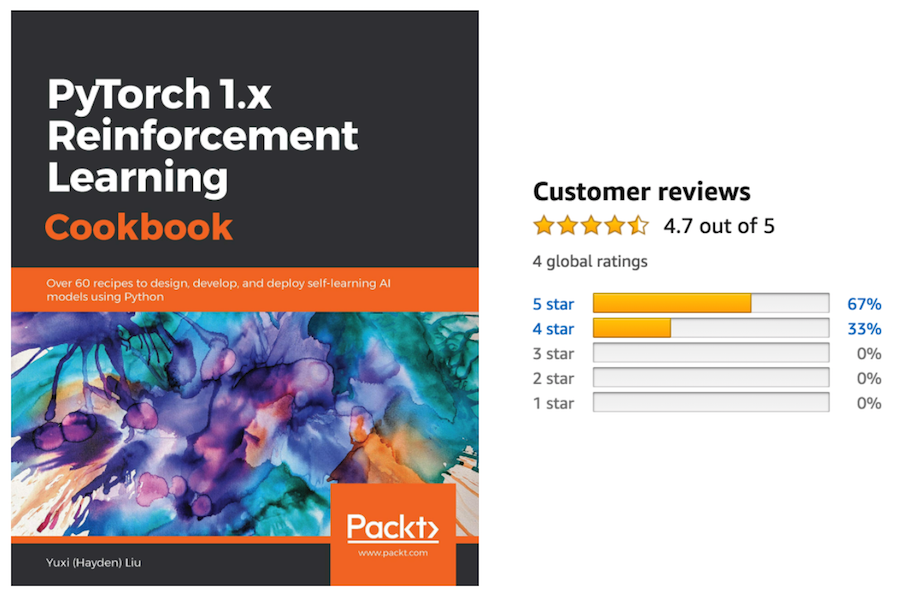PyTorch Reinforcement Learning Cookbook
Over 60 recipes to design, develop, and deploy self-learning AI models using Python
TLDR
Implement reinforcement learning techniques and algorithms with the help of real-world examples and recipes:
- Show me the code
- Preview or get it in Amazon US, India, UK, Canada, or your local Amazon store
- Preview or get it in O’Reilly, Packt
- Preview or get it in Google Play
Key Features
- Use PyTorch 1.x to design and build self-learning artificial intelligence (AI) models
- Implement RL algorithms to solve control and optimization challenges faced by data scientists today
- Apply modern RL libraries to simulate a controlled environment for your projects
Book Description
Reinforcement learning (RL) is a branch of machine learning that has gained popularity in recent times. It allows you to train AI models that learn from their own actions and optimize their behavior. PyTorch has also emerged as the preferred tool for training RL models because of its efficiency and ease of use.
With this book, you’ll explore the important RL concepts and the implementation of algorithms in PyTorch 1.x. The recipes in the book, along with real-world examples, will help you master various RL techniques, such as dynamic programming, Monte Carlo simulations, temporal difference, and Q-learning. You’ll also gain insights into industry-specific applications of these techniques. Later chapters will guide you through solving problems such as the multi-armed bandit problem and the cartpole problem using the multi-armed bandit algorithm and function approximation. You’ll also learn how to use Deep Q-Networks to complete Atari games, along with how to effectively implement policy gradients. Finally, you’ll discover how RL techniques are applied to Blackjack, Gridworld environments, internet advertising, and the Flappy Bird game.
By the end of this book, you’ll have developed the skills you need to implement popular RL algorithms and use RL techniques to solve real-world problems.
What you will learn
- Use Q-learning and the state–action–reward–state–action (SARSA) algorithm to solve various Gridworld problems
- Develop a multi-armed bandit algorithm to optimize display advertising
- Scale up learning and control processes using Deep Q-Networks
- Simulate Markov Decision Processes, OpenAI Gym environments, and other common control problems
- Select and build RL models, evaluate their performance, and optimize and deploy them
- Use policy gradient methods to solve continuous RL problems
Who this book is for
Machine learning engineers, data scientists and AI researchers looking for quick solutions to different reinforcement learning problems will find this book useful. Although prior knowledge of machine learning concepts is required, experience with PyTorch will be useful but not necessary.
Table of Contents
- Getting started with reinforcement learning and PyTorch
- Markov Decision Process and Dynamic Programming
- Monte Carlo Methods for making numerical estimations
- Temporal Difference and Q-Learning
- Solving Multi Armed Bandit problems
- Scaling up Learning with Function Approximation
- Deep Q-Networks in Action
- Implementing Policy Gradients and Policy Optimization
- Capstone Project: Playing Flappy Bird with DQN
What readers said
There are currently 5 reviews in Amazon globally, for example:
Got this book with the recommendation from one of my friend, this book provides good guidance for the people who wish to dive into the career in machine learning, with easy to understand explanations and hands-on code examples. It also teaches you how to think and tackle challenges like an ML engineer using reinforcement learning, which I think it’s more important for a newbie like me.
– From AustinSF (US)There are few very good books about reinforcement learning theory and about hands-on approach, but for someone who is applying reinforcement learning, this is a must to have code reference for RL. people often confuse a cookbook with theory/practical book, but as a cookbook it has everything for SOTA RL from markov methods,Q-learning to policy gradients, that too in pytorch.
Also, author seems well aware of the top trends in the field. Good read.
– From abdul basit (UK)Review in article Review: PyTorch 1.x Reinforcement Learning Cookbook :
This book sticks to a simple organization which makes it easier to find the section that you are looking for. The first chapter is all about setting up your system with PyTorch and the OpenAI Gym environment. Then it touches on a few simpler algorithms to introduce the reader to both technologies. The next seven chapters discuss reinforcement algorithms of increasing complexity. The book then finishes with a chapter with a capstone project, which I have never seen in a cookbook before. I think I like it, as it brings everything together.
In the end…
Let me know if you are interested in reading or reviewing this book, or you want to chat about machine learning.
You may also enjoy my other books:
- Python Machine Learning by Example 2nd Edition
- Hands-On Deep Learning Architectures with Python
- Step-by-Step Machine Learning with Python
- R Deep Learning Projects
Happy reading and learning!

